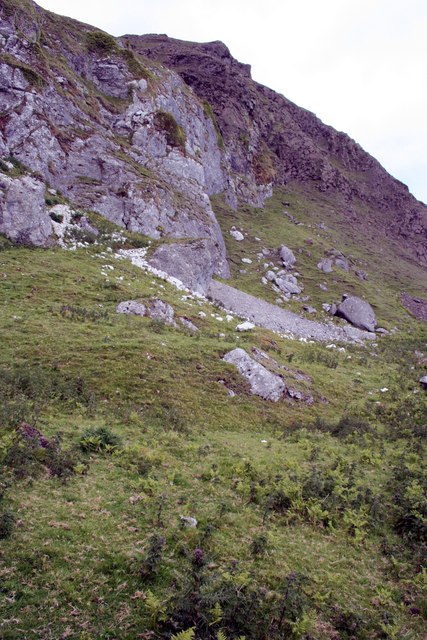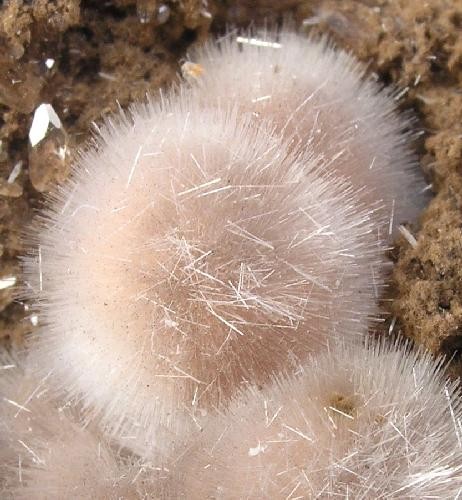|
Scawtite
Scawtite is a hydrous calcium silicate mineral with carbonate, formula: Ca7(Si3O9)2CO3·2H2O. It crystallizes in the monoclinic crystal system as thin plates or flat prisms. Scawtite was first described in 1929 for an occurrence at Scawt Hill in Northern Ireland. Scawtite occurs as in skarns and hydrothermal veins in limestone. Associated minerals include melilite, spurrite, tobermorite, thomsonite, larnite, grossular, bultfonteinite, calcite, analcime Analcime (; ) or analcite is a white, gray, or colorless tectosilicate mineral. Analcime consists of hydrated sodium aluminium silicate in cubic crystalline form. Its chemical formula is Na Al Si2 O6· H2O. Minor amounts of potassium and calciu ..., foshagite and hillebrandite. References {{silicate-mineral-stub Silicate minerals Monoclinic minerals Minerals in space group 12 ... [...More Info...] [...Related Items...] OR: [Wikipedia] [Google] [Baidu] |
Scawt Hill
Scawt Hill is a volcanic plug in County Antrim, Northern Ireland, in the borough of Larne, 5 km from the village of Ballygally. It gets its name from the Ulster Scots "" meaning scaly, scabby or rugged. Alternatively, '' 'scawt' '' meaning scruffy and contemptible, and when applied to rocks, covered in barnacles. Discovery of minerals Scawt Hill is notable for being the type locality for several hydrated calcium silicates, that is, the place where they were first identified. These minerals were formed when the existing chalk of the area was intensely altered by the intrusion of the feeder tube of an ancient volcano, now long since cooled and eroded to its roots.Wilson, H E et al (1986) Geological Survey of Northern Ireland, HMSO Minerals that were first discovered at Scawt Hill: * Larnite (''calcium orthosilicate'') a natural form of belite discovered in 1929 and named after Larne, the nearest town * Scawtite in 1929 * Portlandite in 1933 * Hydrocalumite in 1934 * Ran ... [...More Info...] [...Related Items...] OR: [Wikipedia] [Google] [Baidu] |
Silicate Mineral
Silicate minerals are rock-forming minerals made up of silicate groups. They are the largest and most important class of minerals and make up approximately 90 percent of Earth's crust. In mineralogy, silica (silicon dioxide, ) is usually considered a silicate mineral. Silica is found in nature as the mineral quartz, and its polymorphism (materials science), polymorphs. On Earth, a wide variety of silicate minerals occur in an even wider range of combinations as a result of the processes that have been forming and re-working the crust for billions of years. These processes include partial melting, crystallization, fractionation, metamorphism, weathering, and diagenesis. Living organisms also contribute to this carbonate–silicate cycle, geologic cycle. For example, a type of plankton known as diatoms construct their exoskeletons ("frustules") from silica extracted from seawater. The frustules of dead diatoms are a major constituent of deep ocean sediment, and of diatomaceous e ... [...More Info...] [...Related Items...] OR: [Wikipedia] [Google] [Baidu] |
Spurrite
Spurrite is a white, yellow or light blue mineral with monoclinic crystals. Its chemical formula is Ca5( Si O4)2 CO3. Spurrite is generally formed in contact metamorphism zones as mafic magmas are intruded into carbonate rocks.Smith, J.V. (1960) "The Crystal structure of Spurrite, Ca5(SiO4)2CO3". ''Acta. Cryst.'' 13, 454 Spurrite's space group is P 2/a. It is biaxial with a birefringence of 0.0390–0.0400, giving second order red interference colors when viewed under crossed polarizers in a petrographic microscope. The calcium is in six-fold coordination with the oxygen, the silicon is in a four-fold coordination with the oxygen and the carbon is in two-fold coordination. One unique characteristic of spurrite is that it actually abides by two twin laws. Polysynthetic twinning can occur along its (001) and another type of twinning can occur parallel to its optical axes. Discovery and occurrence Spurrite was first described in 1908 for an occurrence in the Terneras Mine, Ve ... [...More Info...] [...Related Items...] OR: [Wikipedia] [Google] [Baidu] |
Silicate Minerals
Silicate minerals are rock-forming minerals made up of silicate groups. They are the largest and most important class of minerals and make up approximately 90 percent of Earth's crust. In mineralogy, silica (silicon dioxide, ) is usually considered a silicate mineral. Silica is found in nature as the mineral quartz, and its polymorphs. On Earth, a wide variety of silicate minerals occur in an even wider range of combinations as a result of the processes that have been forming and re-working the crust for billions of years. These processes include partial melting, crystallization, fractionation, metamorphism, weathering, and diagenesis. Living organisms also contribute to this geologic cycle. For example, a type of plankton known as diatoms construct their exoskeletons ("frustules") from silica extracted from seawater. The frustules of dead diatoms are a major constituent of deep ocean sediment, and of diatomaceous earth. General structure A silicate mineral is general ... [...More Info...] [...Related Items...] OR: [Wikipedia] [Google] [Baidu] |
Analcime
Analcime (; ) or analcite is a white, gray, or colorless tectosilicate mineral. Analcime consists of hydrated sodium aluminium silicate in cubic crystalline form. Its chemical formula is Na Al Si2 O6· H2O. Minor amounts of potassium and calcium substitute for sodium. A silver-bearing synthetic variety also exists (Ag-analcite). Analcime is usually classified as a zeolite mineral, but structurally and chemically it is more similar to the feldspathoids. Analcime occurs as a primary mineral in analcime basalt and other alkaline igneous rocks. It also occurs as cavity and vesicle fillings associated with prehnite, calcite, and zeolites. Locations Well known locations for sourcing analcime include Croft Quarry in Leicestershire, UK; the Cyclopean Islands east off Sicily and near Trentino in northern Italy; Victoria in Australia; Kerguelen Island in the Indian Ocean; in the Lake Superior copper district of Michigan, Bergen Hill, New Jersey, Golden, Colorado, and at Searles Lake, C ... [...More Info...] [...Related Items...] OR: [Wikipedia] [Google] [Baidu] |
Calcite
Calcite is a Carbonate minerals, carbonate mineral and the most stable Polymorphism (materials science), polymorph of calcium carbonate (CaCO3). It is a very common mineral, particularly as a component of limestone. Calcite defines hardness 3 on the Mohs scale of mineral hardness, based on Scratch hardness, scratch hardness comparison. Large calcite crystals are used in optical equipment, and limestone composed mostly of calcite has numerous uses. Other polymorphs of calcium carbonate are the minerals aragonite and vaterite. Aragonite will change to calcite over timescales of days or less at temperatures exceeding 300 °C, and vaterite is even less stable. Etymology Calcite is derived from the German ''Calcit'', a term from the 19th century that came from the Latin word for Lime (material), lime, ''calx'' (genitive calcis) with the suffix "-ite" used to name minerals. It is thus etymologically related to chalk. When applied by archaeology, archaeologists and stone trade pr ... [...More Info...] [...Related Items...] OR: [Wikipedia] [Google] [Baidu] |
Bultfonteinite
Bultfonteinite, originally dutoitspanite, is a pink to colorless mineral with chemical formula Ca2SiO2(OH,F)4. It was discovered in 1903 or 1904 in the Bultfontein mine in South Africa, for which the mineral is named, and described in 1932. Description Bultfonteinite is transparent and pale pink to colorless. The mineral occurs as radiating prismatic acicular crystals and radial spherules up to . Structure The crystal structure of bultfonteinite consists of strips of a4Si2O4sup>8+, that run along the 5.67 Å ''c''-axis, held together by Ca–O–Ca, Ca–F–Ca, Ca–H2O–Ca, and Ca–O–Si bonds. Silicon atoms occur in isolated tetrahedra and the calcium atoms have seven-fold coordination, derived from a triangular prism with a seventh atom present on one of the square faces. History In either 1903 or 1904, a miner discovered the first specimen of bultfonteinite on the 480-foot level of the Bultfontein mine in Kimberley, South Africa. The mineral occurred in a several-hundr ... [...More Info...] [...Related Items...] OR: [Wikipedia] [Google] [Baidu] |
Grossular
Grossular is a calcium-aluminium species of the garnet group of minerals. It has the chemical formula of Ca3Al2(SiO4)3 but the calcium may, in part, be replaced by ferrous iron and the aluminium by ferric iron. The name grossular is derived from the botanical name for the gooseberry, ''grossularia'', in reference to the green garnet of this composition that is found in Siberia. Other shades include cinnamon brown (cinnamon stone variety), red, and yellow. Grossular is a gemstone. In geological literature, grossular has often been called ''grossularite''. Since 1971, however, use of the term grossularite for the mineral has been discouraged by the International Mineralogical Association. Hessonite Hessonite or "cinnamon stone" is a common variety of grossular with the general formula: Ca3Al2Si3O12. The name comes from the grc, ἣσσων (hēssōn), meaning ''inferior''; an allusion to its lower hardness and lower density than most other garnet species varieties. It has a char ... [...More Info...] [...Related Items...] OR: [Wikipedia] [Google] [Baidu] |
Larnite
Larnite is a calcium silicate mineral with formula: Ca2SiO4. It is the calcium member of the olivine group of minerals. It was first described from an occurrence at Scawt Hill, Larne, Northern Ireland in 1929 by Cecil Edgar Tilley and named for the location. At the type locality it occurs with wollastonite, spurrite, perovskite, merwinite, melilite and gehlenite. It occurs in contact metamorphosed limestones and chalks adjacent to basaltic intrusives. Dicalcium silicate is chemically, β–Ca2SiO4, sometimes represented by the formula 2CaO·SiO2. When used in the cement industry, the mineral is usually referred to as belite Belite is an industrial mineral important in Portland cement manufacture. Its main constituent is dicalcium silicate, Ca2SiO4, sometimes formulated as 2 CaO · SiO2 (C2S in cement chemist notation). Etymology The name was given by Törnebohm in .... References * Nesosilicates Monoclinic minerals Minerals in space group 14 {{silicate-mine ... [...More Info...] [...Related Items...] OR: [Wikipedia] [Google] [Baidu] |
Thomsonite
Thomsonite is the name of a series of tecto-silicate minerals of the zeolite group. Prior to 1997, thomsonite was recognized as a mineral species, but a reclassification in 1997 by the International Mineralogical Association changed it to a series name, with the mineral species being named thomsonite-Ca and thomsonite-Sr. Thomsonite-Ca, by far the more common of the two, is a hydrous sodium, calcium and aluminium silicate, NaCa2Al5Si5O20·6H2O. Strontium can substitute for the calcium and the appropriate species name depends on the dominant element. The species are visually indistinguishable and the series name thomsonite is used whenever testing has not been performed. Globally, thomsonite is one of the rarer zeolites. Thomsonite was first identified in material from Scotland in 1820. It is named for the Scottish chemist Thomas Thomson. The crystal system of thomsonite is orthorhombic. The Mohs hardness is 5 to 5.5. It is transparent to translucent and has a density of 2 ... [...More Info...] [...Related Items...] OR: [Wikipedia] [Google] [Baidu] |





